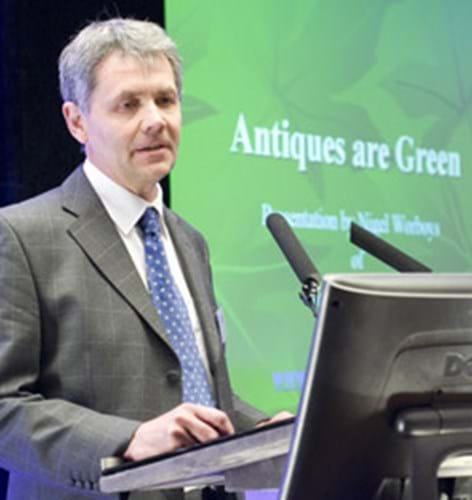
Nigel Worboys here sets out his manifesto for an effective Antiques are Green campaign.
"I have had a retail shop for a number of years but it is only recently that I have really begun to speak to customers about the obviously green credentials of antiques. Now I find that after a few minutes' conversation on the subject there is a look of recognition as the customer first relates antiques to recycling."
As the conversation progresses, it also becomes evident that there are no additional greenhouse gases being produced as a result of their purchase, no rain forests will be depleted or additional raw materials used.
"The customer is now feeling more comfortable about the purchase in the knowledge that 'antiques are green'. They can justify their purchase and they now have that feel-good factor on top.
"But wouldn't it be far easier for us all if the buying public at large were aware of all this before they came in to see us? If they already knew antiques were green because they had read it on numerous occasions in the press and heard about it on TV? If there was the same Antiques are Green logo on show wherever they went?
"Now that opportunity is here and I hope that we all unite - dealers, auctioneers, fair organisers, restorers, publishers, in fact anybody involved in the trade - to make this a roaring success. My proposals for achieving this are set out below."
Aims and objectives
- To promote additional sales and the preservation of antiques by capitalising on their green credentials.
- To attract a new audience who might not have considered antiques before.
- To present antiques as an alternative to a new purchase.
- To develop a sustainable "Not for Profit" business that can continue to support the Antiques are Green message.
- To raise funds for green projects that are related to the trade, such as tree-planting.
- To offer help, advice and incentive for the trade to reduce its carbon footprint.
Why are antiques green?
"I find the best way to illustrate this is by an example. I have chosen the humble Windsor chair, but similar reasoning can be applied to many different antiques, even those which would otherwise be considered only as expensive, luxury items.
"The parts for the Windsor chair were made by craftsmen who lived in the woods where the materials came from. The turnings were produced on treadle-operated lathes, then parts were taken on foot to a local workshop to be assembled. From there the completed chairs would be distributed around the country by horse and cart or waterways.
"That chair has undoubtedly seen hard use, but it is still around today. What a green product and what a life-cycle!
"By buying the chair to use again we have not only conserved our natural resources but avoided the carbon footprint produced by a new chair that might well have come all the way from the Far East.
"What is more, I expect that a new mass-produced chair will hit the waste tip long before the antique Windsor chair is sold again at auction, goes to the restorers to be revived and is retailed again for another 40 years' use!
"In summary, our product is sustainable, re-usable and re-saleable."
How far have we got?
- I have met a number of trade associations and have spoken to 200 delegates at the ATG conference - the majority of whom expressed their full support.
- A website is currently being developed - www.antiquesaregreen.org.
- We are actively canvassing the support of some well-known individuals to help promote the campaign.
- There is a selection of logos to choose from.
What next?
- Decide on a logo. After consideration and feedback from over 100 members of the trade, I have designed a number of logos for you to choose from. You can vote on-line for your favourite, by clicking here.
- Produce a selection of point-of-sale material, and get it on show. I envisage door/cabinet transfers, coasters (we have all seen them put to good use in auction rooms as surface protectors!), display boards, badges, etc (using recycled materials where possible). The Antiques Trade Gazette has kindly offered to distribute POS free of charge as an insertion within the paper.
- Create and develop a website that is of use to the consumer and trade. The focus will be on green issues, but this site will promote the trade in general, sell point of sale material, have links to directories, auction rooms, fairs, shops etc, discuss restoration and repairing. It will have a blog section, so content contribution from the trade will be essential.
- Gain the support of recognised celebrities, campaigners and authorities.
- Encourage the trade to promote "Antiques are Green" from within.
- Talk to the media to try and prepare for future PR.




